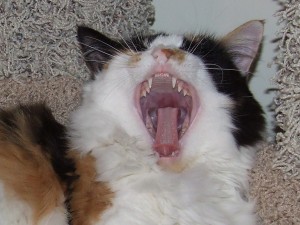 Taking your cat in for a dental is already stressful enough, but what if you found out your vet was conducting – without your knowledge or consent – a potentially harmful procedure while your cat was under? A Procedure for which he then charged you? And charged you again to diagnosis and address the damage it caused?
Taking your cat in for a dental is already stressful enough, but what if you found out your vet was conducting – without your knowledge or consent – a potentially harmful procedure while your cat was under? A Procedure for which he then charged you? And charged you again to diagnosis and address the damage it caused?
One of the benefits of being active in feline forums across multiple platforms is that I can sometime see large scale patterns of illness or behavior. Ear flushing during a dental, without any advance discussion with the owner, is one that recently popped up. This wouldn’t be an issue – in fact, I’d be as unaware as these owners – if it weren’t for the damage these ear flushing procedures often inflict upon the cats.
Here, in her own words, is what happened to just one owner:
“Bugsy had his dental on 13 May. He had two extractions and according to the dentist, all went well. There were no problems with the anesthesia, and nothing went wrong during the procedure.
I had them give Bugsy a shot of famotidine 10mg as he hadn’t eaten for 17 hours by the time I picked him up. When we got home, I noticed the first symptoms: Bugsy would not eat. Bugsy has had many dentals and this had never happened before. I tried processing the food in the smoothie maker, he still wouldn’t eat. Baby food? Nope, nothing. So I initiated syringe-feeding.
Bugsy was also very lethargic; he would sit in one place and not move for hours. He stopped jumping completely. I have two baby gates in my house so they have dog safe rooms – my bedroom, and my office. The litter boxes are in those rooms, too; Bugsy would sit in front of the gate and just look up, unable to enter the room on his own.
His eyes became swollen and his third eye lid began showing. I brought him back to the dentist on the 15th when all symptoms persisted and I started fearing infection, especially from the third eye lid and swollen eyes. They examined him and said his healing was exceptional – much better than the norm, apparently. They removed the sutures just in case that was interfering with his ability to eat.
That night, he started eating soft food on his own. But that night I also noticed a massive amount of black wax in his ear – I had never seen anything like that – his ear was completely filled by that gunk. I tested his hearing, and he could not hear! I cleaned it, and started treating both ears with colloidal silver 500ppm, which I continued for 2 weeks.
A few weeks after the procedure, Bugsy was still not the same – still lethargic, unable to jump as in the past, unable to eat chunks of meat – just not the same. I started getting really worried that something REALLY wrong happened in that dental – could his blood pressure have fallen and affected his kidney?
I was combing through his paperwork when I saw this: “Flush or Clean Ears – Simple”. That was the only thing different in the dental. And to my surprise, when I started researching ear drums ruptured in cats on dentals, ALL symptoms matched to the “T”!
A month later, Bugsy’s eyes are clearing up and his hearing is back, thank goodness – but he is still recovering. He is slowly coming back to what he used to be. This ear flush is not to be taken lightly and I am very lucky Bugsy is not permanently deaf…. I am very lucky I know how to syringe feed, and I was in town to do so. Things could have derailed very easily.”
Upon discussing this in forums with members from all over America (and globally, but this refers only to American feline dentals), we found case after case in which this same scenario played out. Cat goes in for a dental, cat comes out with a clean report, but shortly after returning home begins to exhibit symptoms of a ruptured ear drum: pain, lethargy, inability to walk or jump normally and, sometimes, hearing loss and aggression. Almost invariably, the clinics responsible for the dentals never mentioned the ear flushing, even after the cat was brought back in with symptoms of a ruptured ear drum.
In all things, we must act as our cat’s advocate. When you take your cat in for a dental, have a thorough and straightforward discussion with whomever is doing the procedure. Make sure you know exactly what will be done and why, and that you are crystal clear in return – no ear flushing needed or wanted.
(P.S. If you want to learn how to keep your cat’s oral health at optimal levels without daily brushing or annual dentals click here: Dental Health.)

